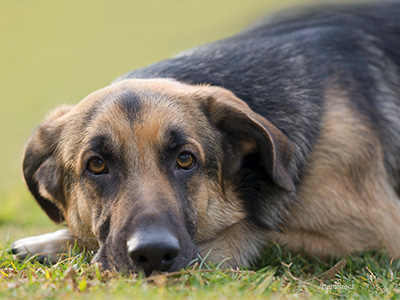
Perianal fistulas are ulcerated tunnel-like formations in the tissues that surround the anal area of dogs1. While a variety of dogs may be affected, older German Shepherds, Setters and Retrievers are most commonly affected. The cause is unknown but affected dogs often have other skin conditions like a broad based tail or deep anal folds. Certain anatomic characteristics have been implicated in the cause2.
Symptoms of perianal fistulas
Signs may include:
- Painful bowel movements
- Constipation
- Diarrhea
- Mucus or blood in stools
- Excessive licking and biting of the anus
Chronic pain in the affected area may make your dog restless and cry every time he is about to defecate. Some affected dogs will struggle or try to bite when their tails are lifted.
Treatment of perianal fistulas
Historically treatment was centered on surgery to remove the diseased tissues. Unfortunately the success rate is not great and there are a number of significant complications including recurrance and inability to control bowel movements.
Medical approaches, including the use of immunosuppressive drugs have proven to be effective in many cases. Stool softeners to reduce straining may help with reducing discomfort. Antibiotics and regular cleaning may also reduce inflammation.
Prognosis of perianal fistulas
Prognosis for initial healing of early lesions is good; however, recurrence is common. Dogs with moderate to severe disease frequently have relapses.
Unfortunately, perianal fistulas may require lifelong medical management with special diets and drugs that suppress the immune system. These drugs can have serious side effects and should never be combined with any other medications (including those for arthritis) unless approved by your primary care veterinarian.
Prevention of perianal fistula
Since German shepherds are at an increased risk for the disease, heredity may play some role in its development; thus, dogs with perianal fistulas should not be bred.
Questions to ask your veterinarian
- My dog was diagnosed with perianal fistulas. How can this condition be treated?
- My dog has some recent ulcerations around his anus and seems to be in pain when he has a bowel movement. What could be the cause?
If you have any questions or concerns, you should always visit or call your veterinarian -- they are your best resource to ensure the health and well-being of your pets.
Resources:
- "Perianal Fistulas." American College of Veterinary Surgeons. Web.
- "Perianal Fistula." Merck Veterinary Manual. Web.
